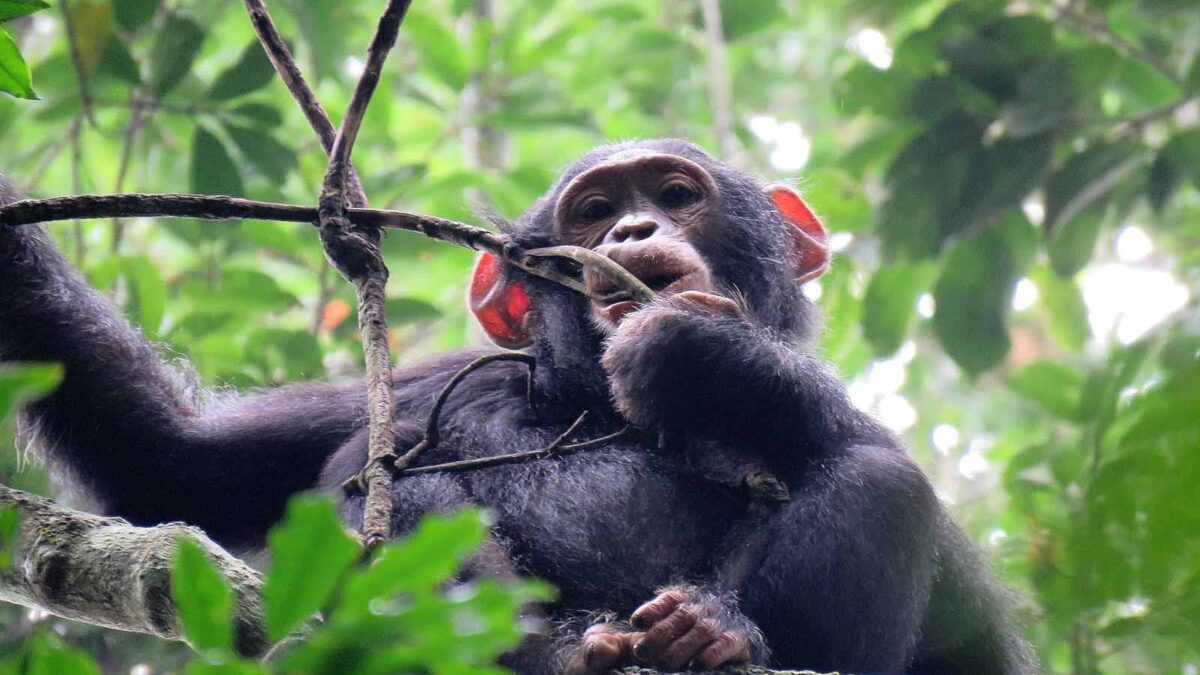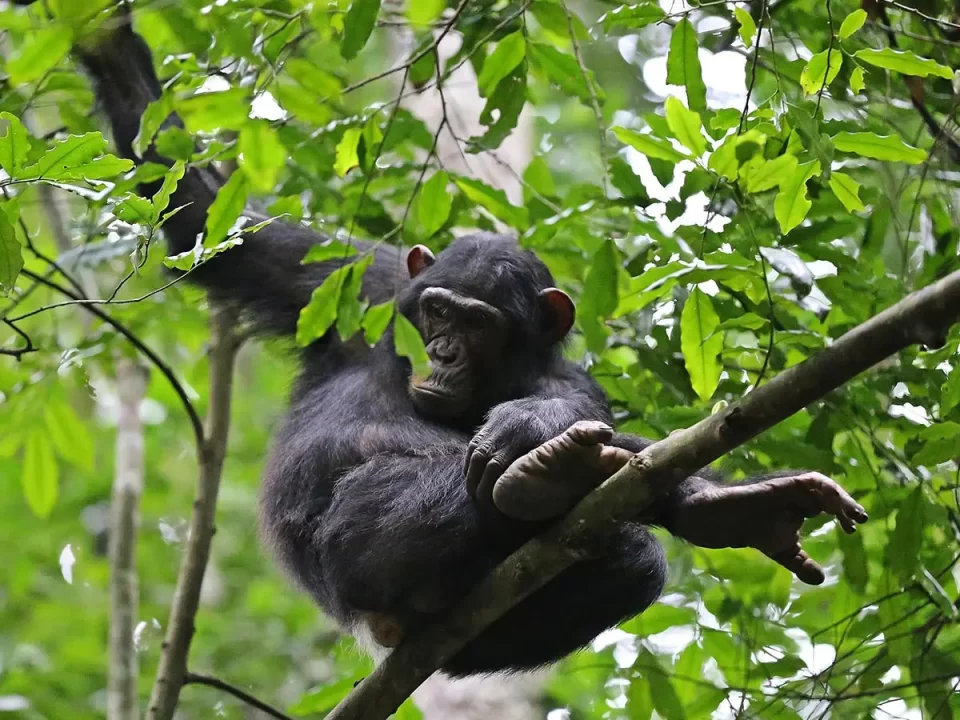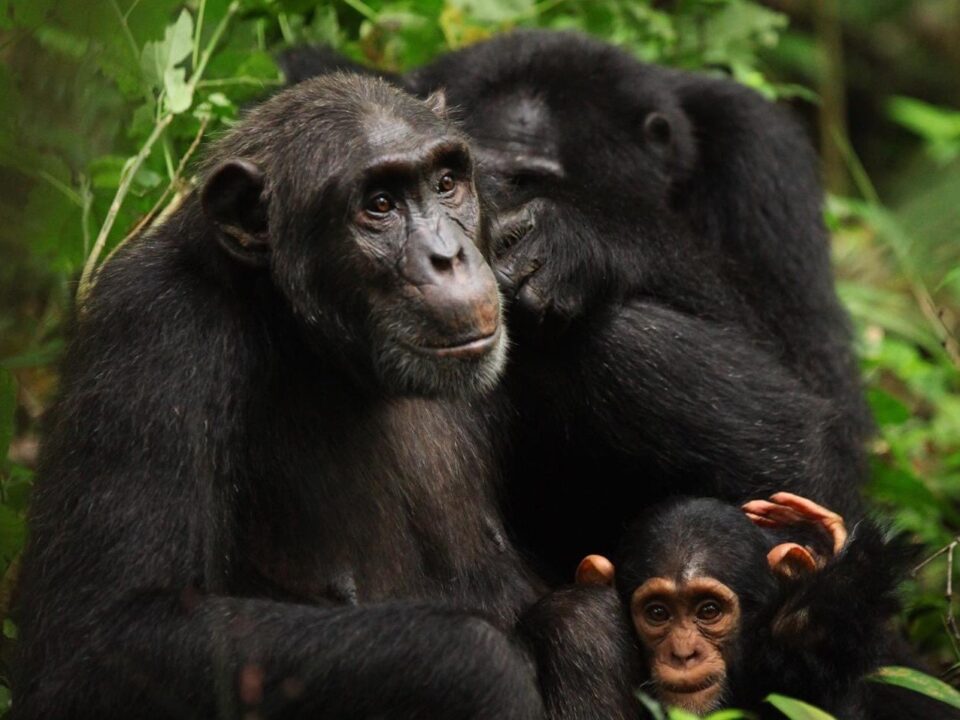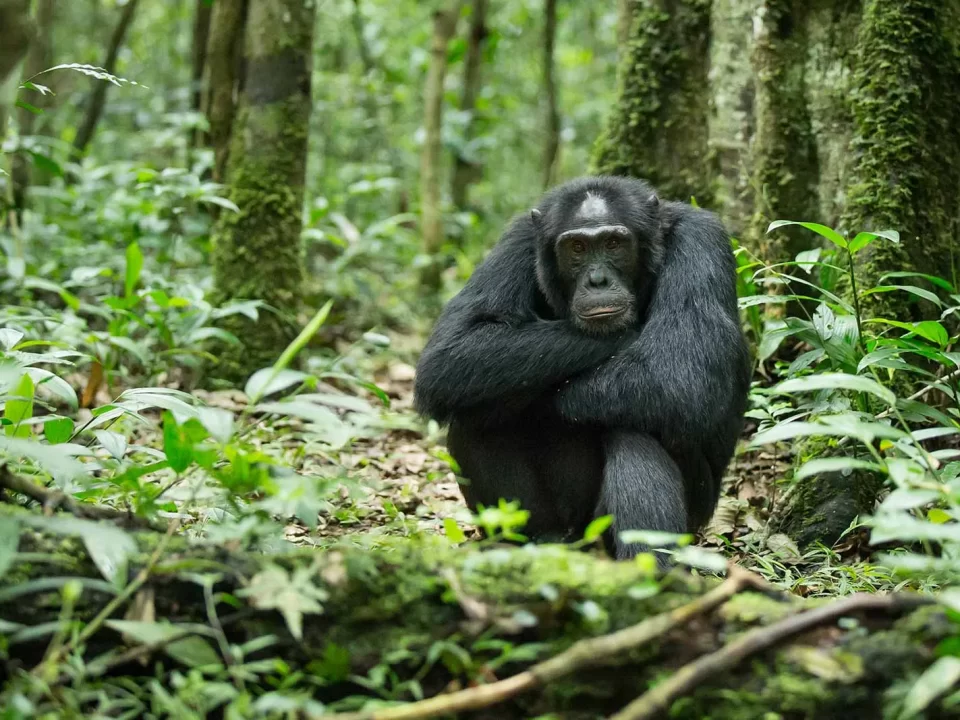About Chimpanzee Trekking in Budongo Forest Reserve
- Home
- African Travel Blog
- Budongo Forest
- About Chimpanzee Trekking in Budongo Forest Reserve
Chimpanzee Trekking in Budongo Forest Reserve
Budongo Forest Reserve, spanning an impressive 825 square kilometers (319 square miles), lies approximately 300 kilometers (4 hours’ drive) northwest of Kampala, the capital city of Uganda. Situated in Masindi District, this vast expanse of lowland rainforest acts as a crucial ecological buffer between human settlements in Masindi District and the abundant wildlife of Murchison Falls National Park. The forest features a diverse landscape, including expansive mahogany tree species, woodlands, thickets, bush, grasslands, and patches of wetland vegetation. Budongo receives an average annual rainfall ranging from 1200mm to 2200mm, making it moist throughout the year. The weather exhibits a distinct pattern, with brief rains occurring from March to May, followed by sunny days from June to August, and heavier rains accompanied by strong winds and thunderstorms from September to November. The months of December to February constitute the dry season, though weather patterns can be influenced by other factors, resulting in occasional sunny days even during the rainy season and heavy rains during the presumed dry season.
Budongo Forest is teeming with life, boasting an impressive array of approximately 470 tree and plant species. The forest is a natural haven for a vibrant array of wildlife, with its residents including 29 mammal species (nine of which are primates), 350 bird species, various insects (290 butterflies and 130 moths), reptiles, and fish. While some of the forest’s inhabitants, such as forest elephants, forest buffalos, giant forest hogs, leopards, pangolins, and others, are elusive and rarely seen, other primates, like olive baboons, black and white colobus, and red-tailed monkeys, are more commonly spotted. However, the main attraction for tourists in Budongo Forest Reserve is chimpanzee trekking.
Budongo Forest is blessed with abundant natural resources, making it a magnet for human activities driven by greed. These include illegal logging for timber and housing construction, expansion for plantations and commercial agriculture, human settlements, charcoal burning, poaching for game meat, livestock grazing, infrastructure development (such as road construction), tourism growth, industrialization, and the oil refinery. To counteract these threats and ensure the preservation and protection of the forest’s wildlife for tourism purposes, the Ugandan government, along with organizations like the Uganda Wildlife Authority, National Forest Authority, and the Jane Goodall Foundation, have joined forces to conserve and safeguard the forest’s sanctity and wildlife.
Chimpanzees (Pan troglodytes), residing in the wilderness of Budongo Forest, share a striking 98.7% of their DNA with humans, making them our closest relatives in the wild. These intelligent creatures have black hair covering their bodies, except for their faces, hands, toes, and hind-quarters. With long arms and legs and five fingers and toes, chimpanzees possess opposable thumbs that aid in grasping and holding objects, using tools, and maintaining balance. They primarily move by walking on both legs and arms in a knuckle-walking fashion. Occasionally, chimpanzees walk on two legs while carrying or transporting items.
Chimpanzees are highly social animals and live in communities, sometimes with as many as 150 members under the leadership of an alpha male. The community members split into smaller groups in the mornings to access resources for survival more efficiently. The alpha male plays an authoritarian role, ensuring security, discipline, direction of movement, feeding and watering areas, and controlling routine activities within the group. He also enjoys privileges such as mating and feeding rights. Chimpanzees start their day at daybreak, searching for areas with abundant food. They rest during the midday hours, engaging in playful behaviors, grooming, guarding, sentry duty, and patrols. They feed again close to evening before building nests to spend the night. At night, they remain quiet and inactive unless faced with threats like predators, thunderstorms, or wildfires.
As omnivores, chimpanzees have a varied diet that includes fruits, plants, fresh vegetation, shoots, barks, rhizomes, root tubers, nuts, eggs, insects, grasses, and even small animals like antelopes, reptiles, birds, and monkeys. They also capture fish in shallow streams, swamps, and ponds when available. While their preferred habitat is the rainforest with an abundance of fruit-bearing trees, chimpanzees can adapt to seasonal inhabitation of woodlands, grasslands, and wetlands to find resources for survival.
The status of chimpanzees in the wild is categorized as “Endangered,” with an estimated global population of only 180,000 to 300,000 individuals, and Budongo Forest Reserve is home to approximately 800 chimpanzees. In their natural habitat, chimpanzees may live up to 45 years old. These creatures face threats from predators like leopards, lions, and crocodiles, as well as natural hazards such as diseases, bushfires, and droughts. However, the most significant threat to their survival comes from human activities, including illegal international wildlife trafficking, capture for zoos, cinema, pets, and scientific research. Some indigenous community members engage in the trade of chimpanzee body parts for rituals and ceremonies, hunt them for game meat, set bushfires that destroy their habitat, and sometimes resort to poisoning, trapping, or killing chimpanzees that encroach on their farmlands. Moreover, human interactions can expose chimpanzees to human diseases and unnatural behaviors, caused by uncontrolled interactions, careless waste disposal, and littering.
To support wildlife protection and conservation efforts, tourists are encouraged to pay conservation fees for chimpanzee tracking in Budongo Forest Reserve. These fees contribute to funding initiatives aimed at safeguarding the wildlife and the forest’s ecological balance.
Chimpanzee Tracking in Budongo Forest Reserve
Before embarking on a chimpanzee tracking expedition in Budongo Forest Reserve, visitors gather at the Kaniyo-Pabidi briefing point. Kaniyo-Pabidi is situated approximately 35 kilometers from the Masindi-Murchison Falls National Park road and an 8-minute drive after passing through the Kichumbanyobo park entrance gate. The chimpanzees in the reserve are habituated by experienced research teams before tourist activities begin. Although these are wild animals, they are accustomed to human presence and remain calm during the tracking experience. Research teams regularly monitor the chimpanzees to ensure their health and well-being. Chimpanzee tracking occurs in two shifts, one in the morning and the other in the afternoon.
To ensure a smooth, safe, and successful expedition, there are guidelines to be followed:
- Gather information about Budongo Forest Reserve, including its climate and weather patterns. The dry season lasts from December to February, while the rainy seasons occur from March to May and from September to November.
- Follow the established chimpanzee tracking guidelines, designed to prioritize the well-being of both tourists and wildlife.
- Obtain a Budongo chimpanzee tracking permit through a reputable tour and safari company. The permit specifies the visitor’s details, such as name, age, gender, residence status, date, and time of tracking, along with the applicable fee.
- Arrive at Kaniyo-Pabidi, the starting point for chimpanzee tracking, at least an hour before the scheduled tracking time. Bring your identification documents and the Budongo Chimpanzee tracking permit.
- The forest guide leads the entourage and should be respected and followed throughout the expedition.
- At Kaniyo-Pabidi, there are eight groups of chimpanzees available for tourism, and each tracking group is limited to six visitors.
- The starting time and duration of the chimpanzee tracking vary, with half-day tracking lasting around 4 hours (either in the morning at 8 am or in the afternoon at 12 pm) and full-day tracking (chimpanzee habituation) starting at 6 am and lasting until 6 pm.
- The minimum age for chimpanzee tracking is 15 years, primarily to minimize the risk of transmitting or contracting communicable diseases.
- Visitors are required to share essential health information with the forest guides and rangers. If feeling unwell and unable to complete the tracking exercise, volunteers can opt-out of the activity.
- Chimpanzees are wild and highly mobile animals, making it impossible to predict the exact duration it takes to locate them during tracking.
- Interaction with the chimpanzees is limited to one hour to minimize disturbance to their natural behavior and habitat.
- During the interaction, visitors must maintain a distance of 8 meters away from the chimpanzees as a crucial health regulation.
- Flash photography is prohibited to avoid disturbing the chimpanzees.
- GPS on electronic devices should be deactivated to prevent any unintended tracking of the animals’ movements.
- Visitors should avoid making body gestures, calls, or imitating chimpanzee behavior unless explicitly advised to do so by the forest guide. Such actions may be misinterpreted by the chimpanzees and trigger unintended reactions.
- Visitors are advised to keep up with the rest of the entourage and request the forest guide to adjust the pace and steps according to their needs.
- Conversations should be kept at a low volume to avoid startling wildlife and to fully enjoy the natural exploration.
- Appropriate dressing is essential to adapt to the wilderness environment and facilitate easy movement. Specific details on dressing are provided below.
- Visitors are encouraged to carry only essential items into the forest. For those needing assistance, porters are available on request for a small fee.
- A lunch pack with high-nutrition snacks and enough drinking water should be carried. Visitors should consume their lunch away from the chimpanzees and ensure all litter is carried out of the forest.
- If nature calls during the expedition, visitors should inform the forest guide.
What to wear for Chimpanzee tracking in Budongo Forest Reserve:
Given the diverse environment of Budongo Forest Reserve, it is essential to dress appropriately for the tracking experience, regardless of the weather conditions. The forest contains gentle rolling hills, woodlands, bush, thickets, grasslands, and during the rainy season, rain runoff forms streams, rivulets, and pools. After rain, the tropical sun can quickly heat up the surroundings. Additionally, some plants and shrubs in the forest have thorns or toxic properties, and tracking entourages may encounter various crawling and flying insects that can be irritating, biting, or stinging. While tracking, there is also a possibility of encountering charging forest elephants, buffaloes, and other mammals. To ensure a comfortable and safe tracking experience, visitors should pack clothing that suits the environmental conditions and potential circumstances. Recommended attire includes:
- Face masks to protect against respiratory irritation and potential disease transmission.
- Light long-sleeved shirts, blouses, and tops in dull colors to shield against the sun and insect bites.
- Safari trousers to protect legs and facilitate comfortable movement.
- Water-proof hiking boots or rubber boots to provide support, traction, and protection against mud and water.
- Poncho or rain gear to shield against rain showers and keep clothing dry.
- Light warm clothing, as weather conditions can vary during the day.
- Strong stockings to protect against insect bites and other potential hazards.
- Garden hand gloves for additional protection when needed.
- Headgear such as a round hat, cap, or head scarf to shield against the sun.
- Sunglasses to protect eyes from harsh sunlight.
- A walking stick can be beneficial and can often be improvised at the starting point.
What to carry for chimpanzee tracking in Budongo Forest Reserve:
While chimpanzee tracking generally lasts only a few hours, certain items can enhance the experience and make it more enjoyable. Some essential items to carry for the expedition include:
- Binoculars to get a closer view of wildlife and birds from a distance.
- A first aid kit with basic supplies for minor injuries and discomforts.
- A camera to capture memorable moments during the tracking experience.
- A lunch pack with nourishing snacks and sufficient drinking water to sustain energy.
- A field guidebook and a notebook with a pencil or pen to jot down observations and interesting findings.
- A map and compass for navigation in case of unfamiliar territory.
- A strong flashlight to aid in exploring the forest, especially in dimly lit areas.
Opportunities for Additional Adventures:
Beyond chimpanzee tracking, Budongo Forest Reserve and its vicinity offer an array of exciting activities to complement the tracking experience. Tourists can partake in the following activities to maximize their adventure:
- Bird watching in Budongo Forest, known for its diverse bird species and vibrant avian life.
- Forest walks, providing a chance to immerse oneself in the natural beauty and tranquility of the rainforest.
- Game viewing safaris in Murchison Falls National Park, where visitors can spot a variety of wildlife, including elephants, giraffes, lions, and more.
- Boat cruises along the Nile River, offering unique perspectives of the surrounding landscapes and wildlife.
- Adventure exploration at the top of Murchison Falls, a magnificent waterfall that captivates visitors with its grandeur.
- Zip-lining at Sambiya River Lodge, an exhilarating activity amidst the wilderness.
- Bokwe Community tour near Kichumbanyobo Gate, providing insights into the local culture and traditions.
- A boat cruise to the Delta for a shoe bill expedition, a rare opportunity to observe this unique bird species.
Accommodation Options:
For a memorable stay in the midst of nature, tourists can consider Budongo Eco-lodge, a gem nestled in the rainforest and sharing a compound with the Kaniyo-Pabidi briefing point. The lodge offers comfortable self-contained cottages with warm showers, as well as shared accommodations for group travelers. Additionally, there is a camping site for those seeking a personal and immersive experience with nocturnal wildlife. For those who wish to venture further into the wilderness, Sambiya River Lodge, featuring a swimming pool and zip-lining activities, is located around a 30-minute drive away on the road to Murchison Falls. Masindi town, approximately 35 kilometers south of Kaniyo-Pabidi, offers a wide range of accommodations to suit various preferences. Other lodging options close to Budongo Forest Reserve include Paraa Safari Lodge, Bakers Lodge, Pakuba Safari Lodge, Red Chilli Hideout, and various other alternatives available in the Paraa area.
Transportation:
Traveling from Kampala Capital City to Budongo Forest Reserve is facilitated by a smooth tarmac road, taking approximately 4 hours by private transport. Private travel offers the advantage of flexibility and is a preferred choice for many visitors. Alternatively, public travel options such as buses and taxis are available up to Masindi Town, from where visitors can arrange private transport for the remaining 35 kilometers to Murchison Falls National Park. Additionally, for those seeking faster travel, light air charter flights can be arranged, with Bugungu Airfield and Pakuba Airfield located at approximately 1-hour and 1-hour 30-minutes’ drive respectively from Budongo Forest Reserve.
Chimpanzee trekking in Budongo Forest Reserve promises an unforgettable experience, offering an opportunity to connect with these intelligent and endangered creatures while exploring the stunning beauty of this precious rain forest ecosystem. By following the guidelines and respecting the natural habitat of the chimpanzees, visitors can contribute to their conservation and support the efforts to protect this unique wilderness for generations to come.






